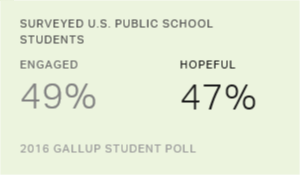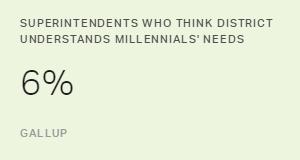Though technology is rapidly transforming how Americans live and work, less than half (40%) of U.S. middle school and high school students report using computers every day at school. For many students, computer science is not a core part of the educational experience. For example:
- Nearly six in 10 (58%) students in grades seven to 12 say their school offers classes dedicated to computer science.
- Slightly fewer (52%) say computer science is taught as part of other classes at their school.
- Less than half (43%) say their school sponsors a computer science group or club.
- One-quarter (25%) report having no access to a computer science class or club at school.
These findings are from Searching for Computer Science: Access and Barriers in U.S. K-12 Education, a new study conducted by Gallup in collaboration with Google. The research builds on Google's 2014 publication, Women Who Choose Computer Science -- What Really Matters, which examined the factors that influence women to pursue computer science careers.
The prior report identified pre-college exposure to computer science as one potential factor in steering women toward technology-based jobs. The new report broadens the scope to examine views of students, parents, teachers and administrators on access to technology and computer science education in U.S. schools. It also gauges the demand for -- and barriers to -- computer science learning. Here are some of the key findings:
Parents express high demand for computer science education. About two-thirds of parents with children in grades seven through 12 (67%) say most students should be required to learn computer science, and those in lower-income households are even more likely to say this. Almost all parents see computer science as a good use of resources at their child's school. More than eight in 10 say it is at least as important as required subjects such as math and English, and nine in 10 say it is at least as important as elective courses such as music and art.
Lower-income students are most likely to lack access to computer science learning opportunities. Access to computer science classes and clubs is generally lowest for students from lower-income households. Inequitable access to computer science education could place these students at a disadvantage as computer technology continues to advance.
Teachers and administrators do not view computer science education as a high priority. Though parents and students appear to place a high value on computer science education, just 7% of principals and 6% of superintendents surveyed report that demand for it is high among parents in their school or district. The majority of educators and administrators surveyed agree or strongly agree that most students should be required to take a computer science course. However, less than a third of superintendents (29%) and less than a quarter of teachers (23%) and principals (24%) agree or strongly agree that computer science education is a top priority at their school or district.
Budgets and competing interests edge out computer science learning opportunities. Principals and superintendents of schools and districts that do not offer computer science classes are most likely to say this is because of limited time to devote to classes that are not tied to testing requirements. They also point to a low availability of and budget for computer science teachers. Few principals and superintendents mention a lack of computer equipment or software as the main reason their schools do not offer computer science, although one-fifth to one-third say it is one of the reasons.
Existing computer science offerings lack core elements. Nearly half (47%) of principals surveyed who say their schools offer computer science courses also say that computer programming and coding -- core elements of computer science -- are not part of the coursework. Only 21% of principals from schools that offer computer science classes say advanced placement computer science courses are available at their schools.
Principals see rising participation and predict expansion of computer science offerings. About half (51%) of the principals surveyed have seen an increase in participation in opportunities to learn computer science at their schools, and a similar percentage (49%) expect these offerings in their schools to increase in the next three years.
Rapid technological advances and the growing number of professions relying on computer science underscore the need for students to become computer literate and gain foundational computer science skills, such as computational thinking and programming/coding. The Searching for Computer Science: Access and Barriers in U.S. K-12 Education report is an important step in helping parents, students, teachers and administrators align their expectations and understand the opportunities and challenges schools face in providing quality computer science education to adequately prepare every student for the future.
Read the full report.

